Inground Pool Kit Tips
On this page you will find inground pool kit tips that should help you get the most from your swimming pool kit!
- Coverage charts
- Constructions Tips
- Chemical Tips
- Plumbing Tips and Drawings
Inground Pool Kit Tips – COVERAGE CHARTS – Pool Bottoms
The following coverage charts give the approximate number of bags of Vermiculite and mixes of vermiculite and Sand Portland Cement needed to install a 2″ pool bottom. The actual quantities required can vary greatly depending on the degree of accuracy maintained during the pool excavation and on differences in pool dimensions among pool manufacturers. We recommend 5-10 bags for the difference in digs.
15 tons of Sand “mason sand” 25qty 80lbs bags of Portland is a great start for most pools and should work great for a 16×32. The mixing Ratio is 7 parts Sand 1 part Portland Cement.
Vermiculite Sand (mason sand) /Portland cement
RECTANGULAR POOL: 16′ X 32′ 36 BAGS 15-20 Tons / 25qty 80lbs Portland
16′ X 36′ 40 BAGS, 18′ X 36′ 43 BAGS, 20′ X 40′ 54 BAGS
GRECIAN: 16’6″ X 32’6″ 36 BAGS, 16’6″ X 35’6″ 39 BAGS, 17’10” X 35’10” 44 BAGS
20’9″ X 40’9″ 51 BAGS
LAZY ELL: 18′ X 43′ 46 BAGS, 20′ X 43′ 51 BAGS
Inground Pool Kit Tips – CONSTRUCTION
WEATHER CONDITIONS AFFECTING VERMICULITE POOL BASES: Very hot and dry conditions, extremely wet ground or heavy rain, and/or freezing temperatures all create problems when working with any kind of concrete, including vermiculite pool bases: On very hot and dry days, the hopper walls and bottom should be misted with water to prevent the water from being sucked out of the concrete too soon and causing premature hydration. Rapid loss of water can cause eventual surface cracking, soft spots, and loss of strength. Very wet conditions can wash out the Portland cement reducing or eliminating any strength and eventually resulting in soft spots and the possibility of wash outs. Very cold conditions will slow down curing time significantly. Allow much more time before walking or working on the bottom during very cold weather. Freezing temperatures will prevent vermiculite concrete from curing properly or from ever achieving full strength.
PREPARATION: A good excavation is very important, if not critical! It will make toweling easier, save time and money, reduce the chances of problems during both installation and the life of the pool! Ideally, the pool will be cut so as to allow exactly 2 inches of vermiculite concrete base.
Inground Pool Kit Tips – CHEMICAL
Store your pool chemicals out of direct sunlight to prevent breakdown by UV rays. Scale and corrosive conditions occur when pH, total alkalinity, calcium hardness and dissolved solids are out of balance. Frequent testing can help prevent these problems before they get out of hand. Please make sure to store pool chemicals out of the reach of children in sealed containers.
CHLORINE
To maintain the proper level of residual chlorine when bather load is heavy, shock your pool once a week with a 3 to 5 times higher than normal dose of chlorine. Chlorine is broken down by the sun’s ultraviolet rays. Using cyanuric acid to stabilize the chlorine in your pool at the beginning of the swim season will help you maximize your chlorine’s efficiency all summer long. Filters remove suspended particles from pool water, but don’t control bacteria or algae. Maintain a residual chlorine level of 1.0-3.0 ppm (parts per million) to kill bacteria and/or algae present in the water.
PH LEVEL
The ideal pH for pool water is 7.5. A pH range of 7.4-7.6 is considered acceptable. Maintaining an alkalinity range from 80-120 ppm will help minimize changes in pH, which can result in scaling and corrosion.
QUALITY
To ensure accurate readings, replace test kit reagents annually. To ensure the highest water quality, test your pool’s pH and free chlorine levels daily, adding chemicals as needed. Proper chemical usage is important for maintaining a healthy pool. Be sure to follow the chemical manufacturer’s instructions closely regarding proper dosage for your size pool. Add an algaecide and chlorine to your pool before covering it for the winter. It will ensure that the water is clear and algae-free when you reopen it the following season.
Inground Pool Kit Tips – Cleaning
DEBRIS
When preparing to open your pool for the season, clean all leaves and other debris off the cover before removing it. By emptying your skimmer baskets frequently, you’ll help minimize the amount of leaves that end up on the bottom of your pool. When cleaning the surface of your pool with a leaf net, work your way around the sides first, then clean from the middle of the pool to the sides. Be sure to empty your leaf net occasionally when cleaning your pool’s surface. Otherwise, the net’s contents may accidentally end up back in the pool. Keep the trees and shrubs around your pool trimmed back to minimize the amount of leaves and debris that end up in the pool.
WATER CLARITY
When opening your pool at the beginning of the season, run your filter around the clock until the water is completely clear. If your pool water appears green or has an unpleasant odor, the problem is probably caused by algae. Test for proper chlorine level, and consult a pool professional if the problem persists. Keeping your filter, pump, lint trap and skimmer baskets clean and in proper working condition will help ensure that your pool water stays sparkling clear. Pool inlets should be adjusted so the surface water is moving in a circular direction. Make a habit of checking and emptying skimmer and pump baskets regularly.
Inground Pool Kit Tips – ENERGY CONSERVATION
To conserve energy, run your pool’s filtration system only during off-peak hours. When leaving for vacation for more than a week, turn off the pool heater, including the pilot light. If you use your pool only on weekends, reduce your heater thermostats settings by eight to ten degrees during the week. Use fencing, hedges or other landscaping, or cabanas to shelter your pool from prevailing winds. According to the National Swimming Pool Institute and the American Red Cross, the most healthful swimming temperature is 78 degrees. Reducing your heater thermostat to maintain a 78 degree or lower temperature will also help conserve energy. When reopening your pool for a new season, make sure your pump and filter are working properly before adding chemicals to the water. If your pool heater is more than five years old, chances are a new high efficiency gas heater such as a Heat Pump could quickly pay for itself in utility bill savings. To obtain maximum filtration and energy efficiency, backwash or clean your filter regularly, as required.
Inground Pool Kit Tips- Equipment
CLEANERS
An automatic pool cleaner will dramatically reduce the time spent on weekly maintenance. If you fill your pool with well water, you’ll need to add a metal remover.
FILTERS
When cleaning cartridge filters, soak them in a cleaning solution for 24 hours, then hose them off before reinstalling. D.E. filters should be disassembled and cleaned at least once per season. Is your sand filter 3-5 years old? If so, ask your pool professional if it’s time to replace the sand. If your filter pressure gauge indicates that pressure has dropped below the normal reading for a clean filter, check to see if you have a clogged pump or skimmer basket. Cleaning your sand or D.E. filters when you close your pool for the season will ensure that they are ready for action when you open your pool the following summer. To obtain maximum filtration and energy efficiency, backwash or clean your filter regularly, as required.
GASKETS, O-RINGS, & RUBBER FITTINGS
If your pool has a deck-mounted junction box, check the condition of the gaskets regularly–and replace as needed–to make sure the box cannot be penetrated by water. When closing your pool for the season, coat all accessible o-rings, rubber fittings, and gaskets with a silicone O-ring lube to keep them from drying out.
HEATERS
To maintain your heater’s heating efficiency, follow a regular program of preventive maintenance, including annual inspection and de-liming of the heat exchanger when necessary.
LIGHTING
The addition of fiber optic or automated color changing lighting can dramatically enhance your nighttime pool enjoyment.
PUMPS
Turn the pool pump off before operating the multiport valve. If your pump starts running louder or making unusual noises, shut it off and contact your pool professional. If your pump motor hums but will not start, turn off the power and check to see if the impeller is clogged with debris. Make a habit of checking and emptying skimmer and pump baskets regularly.
SKIMMERS
To prevent your skimmer basket from tipping over when the pump switches on or off, place a small weight or rock in the bottom (the weight must be larger than the suction pipe below the basket). Check to make sure the skimmer weir is in place and is moving freely. Make a habit of checking and emptying skimmer and pump baskets regularly.
WATER LEVELS
Maintain your pool water level halfway up the skimmer box opening. Normally, a pool should lose no more than 1/4 inch of water per day. If you notice a greater loss, suspect a leak. Loose tiles or cracks in the pool deck may be an indication of a leaking pool. Cracks and gaps in the bond beam may be an indication that your pool is leaking. If you notice water-saturated soils in the area around the pool, pool pumps or plumbing, your pool may be leaking. If you see bubbles in the return water when the pool’s pump is running, it’s likely there’s a leak in the suction side of the filtration system.
Classic Inground Swimming Pool or Spa Plumbing
Classic Inground Swimming Pool & Spa Combo System
Inground Swimming Pump Pool Solar System
Booster Pump Inground Pool Cleaner Plumbing
Inground Swimming Pool Waterfall Plumbing
Swimming Pool Two Pump Single Heater System
Inground Swimming Pool & Spa Combo System W/ Ozone and Chemical Feeder
Inground Swimming Pool & Spa Combo System W/ Ozone and Chemical Feeder Bypass Venturi, Inline Feeder
Basic Pool and Spa Combination Plumbing
With separate Filter Pump and Jet Pump
Inground Pool Kit Tips – Questions
If you have questions about our inground pool kit tips please feel free to give us a call at 1-800-515-1747 or send us an email, [email protected]. Want to see how our swimming pool kits are installed? Check out YouTube page: swimming pool kits.
At Pool Warehouse, We Know Swimming Pools!
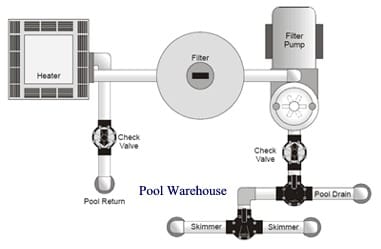

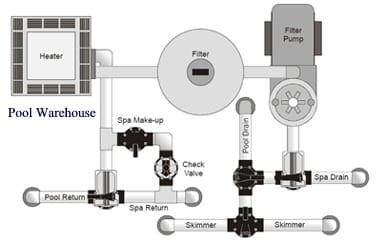
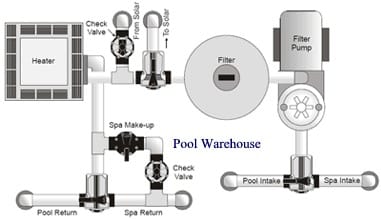
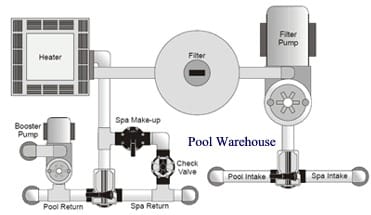
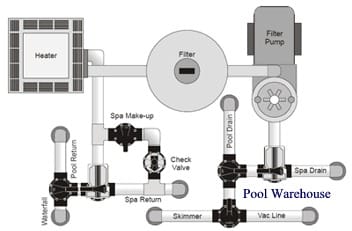
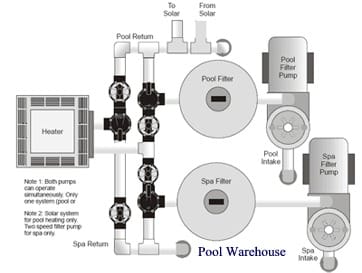
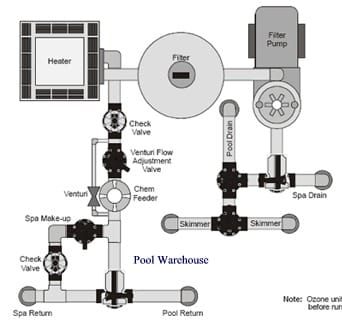
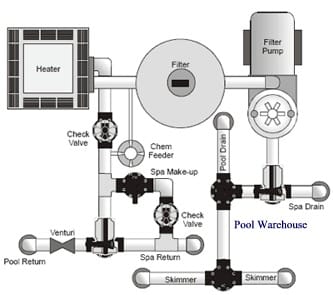
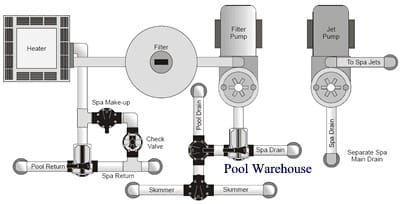
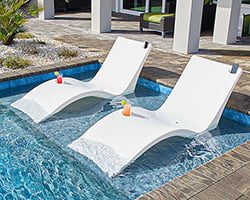


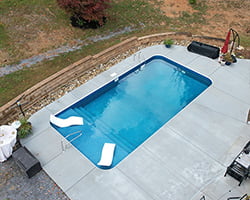


 What are our customers saying?
What are our customers saying?
